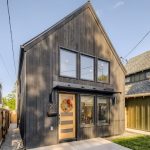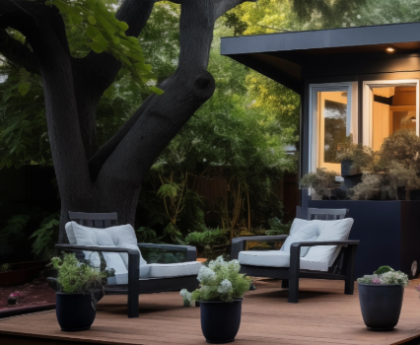AARP Nebraska has announced the winners of its accessory dwelling units competition at the same time as the City of Omaha Planning Department is finalizing possible new regulations for that housing type.
An accessory dwelling unit, or ADU, is an additional small house or apartment set on a single-family residential property. If changes are approved by the City Council, Omaha would allow ADUs across the city and not just in its midtown and eastern areas.
“We are going to have a whole zoning code update related to ADUs,” said Eric Englund, assistant planning director for the Omaha Planning Department.
The architecture firms and the city’s permits and inspections staff also plan to work together, a cooperation that could speed up approval of building permits by preapproving the winning designs, an option called fast-track permitting.
People are also reading…
Once they have been reviewed for applicable building code requirements by the city, interested parties could use the designs to build on their property, saving weeks in permit review time and costs by not needing to hire an architect for individual design.
Englund said the city desperately needs more housing, and ADUs are an excellent option, especially for older adults.
That’s one of the reasons that AARP sponsored the “An ADU for U” competition, which was won by Alley Poyner Macchietto Architecture in partnership with Assistology LLC. Second place went to Straightline Design Inc., third to Actual Architecture Co. and honorable mention to Macondo LLC. They will be honored at a reception later this month.
“The growing population of older adults in the Omaha area and across the U.S. is putting a squeeze on the supply of housing for this demographic,” AARP Nebraska’s State Director Todd Stubbendieck said. “ADUs are an affordable but underutilized housing option that could be the answer for many families.”
Meaghan Walls of Assistology, who does accessibility and universal design consulting, said one in six adults in the U.S. was over 65 in 2020, and that number keeps growing. There’s just under 56 million over the age of 65.
Many older adults experience disability, and that was taken into account in coming up with the winning design, which includes raised garden beds, access to nature and creative storage options.
“Six percent of U.S. housing is considered accessible,” she said. “So there is a disconnect in what accessible housing options are out there for people, and traditional senior living is increasingly unaffordable.”
Daniel Conaway, who was part of the four-person design team for Alley Poyner Macchietto Architecture, said ADUs are very popular on the West Coast and are just beginning to make an appearance in this area.
ADUs are not tiny houses. A typical two-car garage is about 400 square feet. The winning entry is about 675 square feet with living, kitchen and sleeping areas. It is accessible for someone in a wheelchair or walker.
The cost is similar to building a home but on a much smaller scale. A typical unit might cost around $150,000, Englund said.
While having a place for aging parents who still want some independence is a big draw, Conaway said ADUs are for everyone.
“They are for people who are looking for either additional living space on their property,” he said. “They are also used for people who want to rent them out for additional income. They are also an option for a child who is aging out of your place but still doesn’t have their feet under them. Or someone who needs part-time care. They can have independence and still have that accessibility for someone to watch over them.”
Englund said they are still finalizing other criteria for ADUs, which can be built in a basement, over a garage or as a detached unit in the backyard. They are aiming for the proposed code to be ready for the Dec. 6 Planning Board meeting.
He doesn’t expect a rush of new buildings even if they can be built citywide. ADUs have existed in some of Omaha’s older neighborhoods for generations. Zoning code changes that followed the advent of the ORBT bus system in 2020 opened up more neighborhoods for this housing type, but no permits have yet been drawn.
“While it is a more affordable option, it’s still not going to be cheap to build,” he said. “However, other cities that have opened these up have had great success.”
Marjie Ducey’s favorite house stories in 2022
#lee-outstream-wrap {
height: 100%;
width: 100%;
max-width: 800px;
margin: 0 auto;
display: none;
position: relative;
}
#lee-outstream-wrap .ima-controls-div { z-index: 99; }
#lee-outstream-wrap .lee-outstream-video {
position: relative;
padding-bottom: 56.25%;
height: 0;
}
#lee-outstream-wrap .lee-outstream-video video {
position: absolute;
top: 0;
left: 0;
width: 100%;
height: 100%;
z-index:1;
}
#lee-outstream-close {
display: none;
position: absolute;
cursor: pointer;
top: -25px;
left: -25px;
padding: 10px;
overflow: hidden;
background-color: #000;
border-radius: 20px;
color: #fff;
z-index: 99;
line-height: 0;
box-shadow: rgba(0, 0, 0, 0.4) 0px 0px 5px 0px;
}
#lee-outstream-close:hover { color: rgba(255,255,255,.8); }
#lee-outstream-wrap.sticky {
position: fixed;
bottom:0;
right:0;
width: 400px;
z-index: 1000;
height: auto;
box-shadow: rgba(0, 0, 0, 0.4) 0px 0px 10px 0px;
}
#lee-outstream-wrap.sticky #lee-outstream-close{ display: block; }
@media (max-width: 767px){
#lee-outstream-wrap.sticky { width: 60%; }
}
[email protected], 402-444-1034, twitter.com/mduceyowh
#lee-rev-content { margin:0 -5px; }
#lee-rev-content h3 {
font-family: inherit!important;
font-weight: 700!important;
border-left: 8px solid var(–lee-blox-link-color);
text-indent: 7px;
font-size: 24px!important;
line-height: 24px;
}
#lee-rev-content .rc-provider {
font-family: inherit!important;
}
#lee-rev-content h4 {
line-height: 24px!important;
font-family: “serif-ds”,Times,”Times New Roman”,serif!important;
margin-top: 10px!important;
}
@media (max-width: 991px) {
#lee-rev-content h3 {
font-size: 18px!important;
line-height: 18px;
}
}
#pu-email-form-business-email-article {
clear: both;
background-color: #fff;
color: #222;
background-position: bottom;
background-repeat: no-repeat;
padding: 15px 0 20px;
margin-bottom: 40px;
border-top: 4px solid rgba(0,0,0,.8);
border-bottom: 1px solid rgba(0,0,0,.2);
display: none;
}
#pu-email-form-business-email-article,
#pu-email-form-business-email-article p {
font-family: -apple-system, BlinkMacSystemFont, “Segoe UI”, Helvetica, Arial, sans-serif, “Apple Color Emoji”, “Segoe UI Emoji”, “Segoe UI Symbol”;
}
#pu-email-form-business-email-article h2 {
font-size: 24px;
margin: 15px 0 5px 0;
font-family: “serif-ds”, Times, “Times New Roman”, serif;
}
#pu-email-form-business-email-article .lead {
margin-bottom: 5px;
}
#pu-email-form-business-email-article .email-desc {
font-size: 16px;
line-height: 20px;
margin-bottom: 5px;
opacity: 0.7;
}
#pu-email-form-business-email-article form {
padding: 10px 30px 5px 30px;
}
#pu-email-form-business-email-article .disclaimer {
opacity: 0.5;
margin-bottom: 0;
line-height: 100%;
}
#pu-email-form-business-email-article .disclaimer a {
color: #222;
text-decoration: underline;
}
#pu-email-form-business-email-article .email-hammer {
border-bottom: 3px solid #222;
opacity: .5;
display: inline-block;
padding: 0 10px 5px 10px;
margin-bottom: -5px;
font-size: 16px;
}
@media (max-width: 991px) {
#pu-email-form-business-email-article form {
padding: 10px 0 5px 0;
}
}
.grecaptcha-badge { visibility: hidden; }





